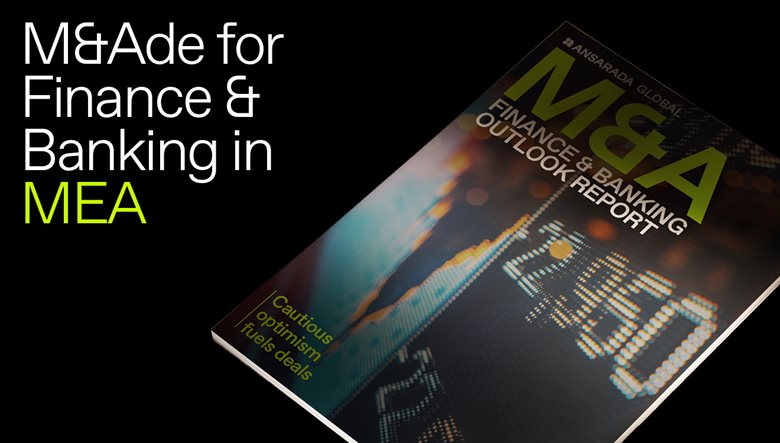Middle East and Africa’s finance sector shows resilience with 80% growth
Economic diversification and infrastructure investment drive Middle East and Africa's strong M&A performance despite regional headwinds and evolving regulatory landscapes.
By AnsaradaFri Jun 13 2025Mergers and acquisitions, Advisors, Industry news and trends

The Middle East and Africa (MEA) region has demonstrated resilience in the global finance and banking M&A sector, showing strong growth momentum despite facing unique regional challenges and global market uncertainty.
According to Deal Room data from our 2025 Global Finance & Banking M&A Outlook Report, MEA achieved an impressive 80% growth in deal room activity over the past 12 months, positioning it as the third-strongest performing region globally behind ANZ (92%) and the Americas (82%). This performance outpaced Europe (74%) and Asia (79%), demonstrating the region's growing attractiveness for financial services transactions.
Notably, MEA showed the most resilience during recent market volatility, experiencing only a 35% quarterly decline in deal room activity compared to steeper falls in other regions such as Asia (-69%) and Europe (-59%). This relative stability reflects ongoing economic diversification efforts and sustained investment in financial services infrastructure across the region.
Market dynamics and regional drivers
The MEA region's strong performance is underpinned by several key structural factors that continue to drive M&A activity. Dr. Nicholas Hanser, Managing Partner, Head of Technology (TMT) Investment Banking – M&A at Saxenhammer, notes that regions like MEA "indicate stronger resilience in these markets due to ongoing economic diversification efforts and sustained investment in financial services infrastructure."
This diversification trend is particularly evident in the Gulf Cooperation Council (GCC) countries, where governments continue to implement Vision 2030-style economic transformation programs. These initiatives are creating opportunities for financial institutions to expand their digital capabilities, enhance their geographic footprint, and pursue strategic partnerships that support broader economic objectives.
The region's banking sector has seen significant activity, with MEA recording $2.1 billion across 15 major deals during the reporting period. This activity reflects ongoing consolidation as regional banks seek to build scale and operational efficiency while competing with international players.
Sector-specific insights
Banking sector consolidation
The MEA banking sector continues to experience strategic consolidation as institutions pursue scale to compete more effectively in an increasingly digital landscape. Regional banks are focusing on technology investments and geographic expansion to serve growing economies and evolving customer needs.
This consolidation trend is evident across multiple markets, with Kuwaiti lenders Warba and Gulf Bank currently exploring a merger that would enhance long-term growth and competitiveness through leveraging synergies and capabilities, particularly in the local Islamic banking sector.
Similarly, the technology transformation driving these consolidation efforts is particularly pronounced in the Gulf region. Recent analysis by Finastra highlights that AI adoption in Middle Eastern banking could significantly boost GDP, with UAE and Saudi Arabian banks accelerating AI deployment for operational efficiency, risk management and enhanced customer experience.
The World Economic Forum has noted that Middle Eastern banks are gearing up for widespread AI adoption with substantial investments supported by a favorable regulatory environment, underscoring the region's commitment to technological advancement.
Insurance market development
The insurance sector in MEA recorded $749 million across 13 deals, with July 2024 being particularly active with five deals worth $392 million. This activity reflects the sector's ongoing development as insurance penetration rates increase across the region.
International insurance groups continue to view MEA as an attractive market for expansion, particularly in commercial lines and specialty insurance products. This renewed interest is evident in the market's increasing capacity, as The Gallagher Market Report for the MEA region 2025 notes that: "The GCC insurance sector is seeing large investments from international brokers, while (re)insurers seen departing the market in 2019/2020 are returning, adding to the significant capacity available in the regional market and creating further choice for clients." The return of these international players demonstrates the region's restored attractiveness after previous market exits.
Fintech and digital transformation
The MEA region's fintech sector is experiencing significant growth, supported by government initiatives promoting financial inclusion and digital payments, such as Saudi Vision 2030's ambitious goals to establish over 525 fintech companies and generate substantial GDP contributions from the sector by 2030.
This creates opportunities for traditional financial institutions to acquire innovative technology companies or form strategic partnerships to accelerate their digital transformation. For instance, Emirates NBD, a leading bank in the UAE, has a clear fintech strategy focused on collaborations, establishing a US$100 million Emirates NBD Innovation Fund to invest in relevant fintech, banktech, and enterprise tech companies.
Mobile banking and payment solutions are particularly attractive, given the region's young demographics and increasing smartphone penetration. These trends are creating opportunities for both domestic and international acquirers seeking to capitalize on the growing digital finance ecosystem, as evidenced by the rapid growth of mobile wallets.
Regional investment flows and international interest
MEA's strategic location between Europe, Asia, and the broader African continent continues to attract international investment. European financial institutions view the region as a gateway to growing African markets, while Asian investors, particularly from China and India, are increasingly active in pursuing strategic opportunities.
The region's sovereign wealth funds are also playing an increasingly important role in M&A activity, both as acquirers of international assets and as partners in domestic consolidation initiatives. These funds bring significant capital and long-term investment horizons that support complex, transformative transactions.
Dr. Hanser notes that "the AMER and MEA regions are poised to leverage their relatively stronger economic fundamentals and liquidity positions to seek strategic international opportunities, contrasting somewhat with the more subdued environment in Europe." This positions MEA institutions to be active acquirers in global markets while continuing to attract inbound investment.
2025 outlook and predictions
Despite global headwinds including trade tensions and geopolitical uncertainty, MEA's finance and banking sector is well-positioned for continued M&A activity in 2025. Several factors support this optimistic outlook:
-
Economic diversification momentum: Ongoing government initiatives to diversify economies away from oil dependence continue to create opportunities for financial services expansion and innovation.
-
Infrastructure investment: Major infrastructure projects across the region require sophisticated financing solutions, creating opportunities for project finance specialists and infrastructure-focused financial institutions.
-
Digital transformation acceleration: The continued push toward digitalization creates ongoing demand for fintech acquisitions and technology partnerships.
-
Regional integration: Deeper economic integration within sub-regions is facilitating cross-border consolidation and creating economies of scale.
-
International gateway positioning: MEA's role as a bridge between developed and emerging markets continues to attract international financial institutions seeking regional expansion platforms.
Conclusion
MEA's impressive 80% year-on-year growth in deal room activity, combined with its relative resilience during recent market volatility, demonstrates the region's strong fundamentals and attractive investment proposition. The combination of economic diversification, infrastructure investment, and digital transformation continues to drive strategic consolidation and cross-border activity.
Financial institutions in MEA are well-positioned to capitalize on both domestic consolidation opportunities and international expansion initiatives. The region's strategic location, growing economies, and evolving regulatory landscape create a compelling environment for M&A activity.
As Dr. Hanser concludes, the region's "relatively stronger economic fundamentals and liquidity positions" position MEA institutions to be active participants in global M&A markets while continuing to attract international investment. With normalized deal processes and continued government support for economic transformation, 2025 looks set to be another strong year for finance and banking M&A in the MEA region.
The key to success will be identifying opportunities that align with broader economic transformation themes while navigating the diverse regulatory and market conditions across the region.


